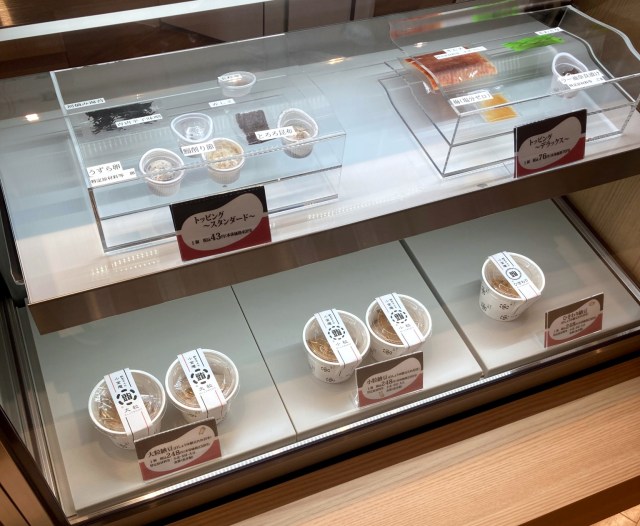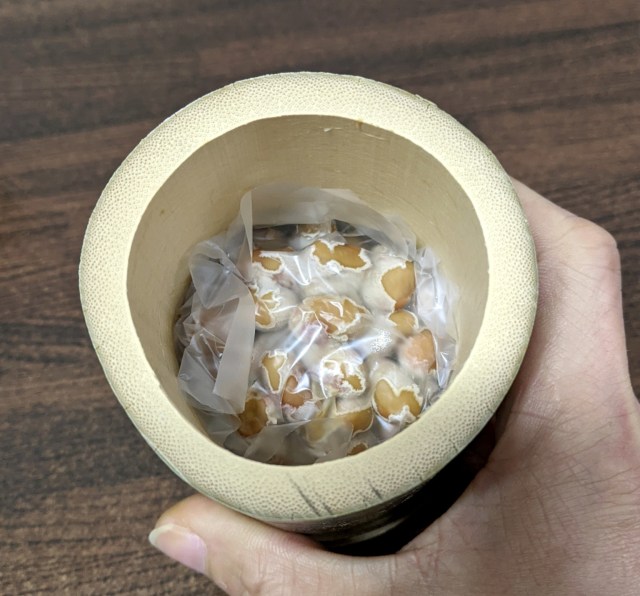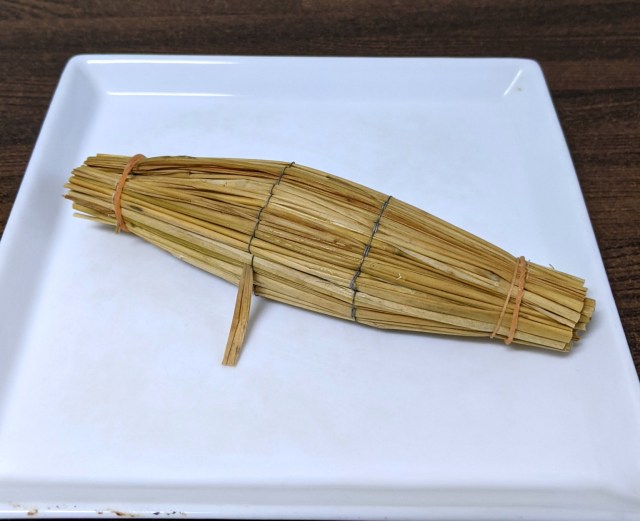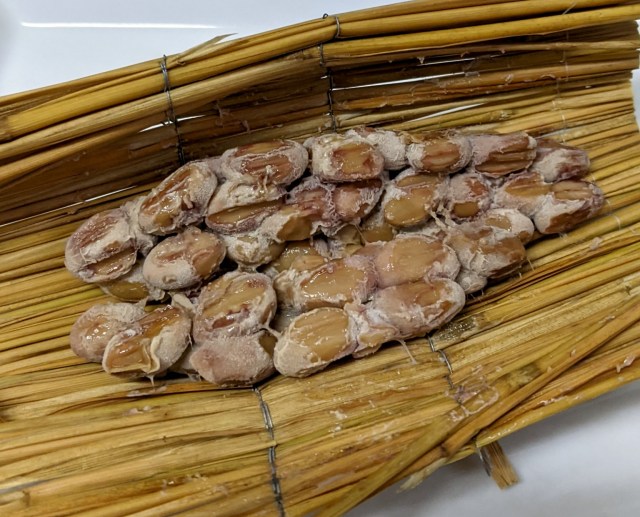
Could this be the answer that all natto-nay sayers have been searching for?
Out of all the traditional food that Japan has to offer, you’ll struggle to find one that’s more divisive than natto, or fermented soy beans. Natto has a reputation of being notoriously despised by foreigners, due in large part to its distinctive aroma and mucus-like texture. But it’s not just non-Japanese who find natto polarising — a recent online survey found that around 62 percent of Japanese people enjoy eating natto, but the remaining 38 percent of respondents claimed they found it only tolerable or didn’t like it at all, claiming to only eat it for its nutritional benefits.
Our crack reporter Mr. Sato isn’t particularly averse to natto though, and in fact quite enjoys the taste. For him, the ammonia-like smell that accompanies a bowl of natto is just part of the experience, and something he’s become accustomed to. Just like the great philosopher Dolly Parton once said, “if you want the natto rainbow, you gotta put up with the natto rain.”
Still, he understands why natto can be so polarising, and thinks he may have stumbled across a solution to turn almost anyone into a fan of the fermented soy beans: a store selling custom-order natto.
Called Natto Bar Koganean, the store is located in Tokyo’s Kuramae District, and is Japan’s first customisable natto store. The concept of the store is to order natto the way you like it, just as you would cocktails in a bar.
There are many elements that you can customise to make your own preferred natto. There are three sizes of soybean: big, small, and coarsely ground. There are also ten toppings to choose from: dried kelp flakes, kimchi, onion, ume plum, seaweed, red shiso (beefsteak plant), quail egg, dried bonito flakes, green chilli miso, wasabi, and chilli oil. If you can’t choose, you can pick from the pre-made natto pots, pictured above.
Mr. Sato was mulling over which combination of natto to get when something else caught his eye. He’d spotted a packet of Naniwara natto (594 yen / US$4.48) and a packet of Takehime natto (648 yen / US$4.89).
Natto was traditionally made by wrapping cooked soybeans in rice straw and letting them ferment, and it seemed both the Naniwara (wrapped in rice straw) and Takehime (wrapped in bamboo) natto were made in a similar fashion. The soybeans used for the natto were domestically grown, and the natto culture was made from a natural strain found on rice straw.
Mr. Sato decided to taste test the Takehime natto first. Most natto comes in a plastic box or cup, so he was surprised to see the natto nestled inside the bamboo itself.
The soybeans were big and beautifully round, and looked nice and firm. Mr. Sato believes that the bigger the bean is, the tastier it will be, so he was expecting a explosion of flavour with this natto!
The Naniwara natto came wrapped in rice straw, which didn’t seem to be an ideal container for natto…
… but as Mr. Sato unwrapped the straw parcel, the beans inside were perfectly fermented, thanks to the natural cultures found on the rice straw. Unlike the bamboo, the rice straw wasn’t just a nifty way to contain the natto; it was actually used to make the natto itself!
These beans were also nice and big, but they weren’t as sticky as the ones in the Takehime natto were. They were more slimy, and Mr. Sato prefers a sticky bean to a slimy bean. But more than anything, Mr. Sato was surprised at the smell of the natto. He had been expecting that familiar, putrid scent to waft to his nostrils, but instead was met with the aroma of… absolutely nothing. The natto didn’t smell of anything at all!
For someone like Mr. Sato, who believed that natto, by definition, is “stinky but tasty”, this discovery rocked him to his very core. Up until now, natto claiming to be ‘odorless’ had left him disappointed, but this natto seemed to tick all the right boxes. It looked like natto, and if it tasted like natto then the possibilities would be endless!
The soybeans had a firm but chewy texture, and Mr. Sato could taste a mild sweetness from the soybeans. It was a very delicious but mild-tasting natto, though, so Mr. Sato recommends trying it with a dash of soy sauce. According to Natto Bar Koganean’s online store, it tastes even better when mixed in with the rice, and also with a hint of salt to bring out the sweetness even more, but Mr. Sato didn’t read this until after he’d polished off his bowl. Oops!
So in the end, Mr. Sato got to enjoy a tasty bowl of natto without having to endure the smell, and may never be able to go back to regular supermarket natto again. Aside from the store Mr. Sato visited, there is a branch in Osaka’s Tosabori District, and all natto can be custom-ordered online, and for anyone who is put off from eating natto because of how it smells, Mr. Sato recommends you give Natto Bar Koganean a try.
Restaurant Information
Natto Bar Koganean (Kuramae branch) // 納豆BAR 小金庵(蔵前店)
Address: Taito-ku, Kuramae 3-18-4 Life Core Kuramae 102
東京都台東区蔵前3丁目18-4 ライフコア蔵前102
Open 10 a.m. -7 p.m.
Closed Wednesdays
Website
Photos ©SoraNews24
● Want to hear about SoraNews24’s latest articles as soon as they’re published? Follow us on Facebook and Twitter!
[ Read in Japanese ]











 Mizkan develops world’s most “beautiful” natto, Mr. Sato takes it for a spin
Mizkan develops world’s most “beautiful” natto, Mr. Sato takes it for a spin We spice up our fermented soybeans with curry powder flavored natto【Taste Test】
We spice up our fermented soybeans with curry powder flavored natto【Taste Test】 All-you-can-eat stinky fermented soybeans come to Ginza, if that’s your thing
All-you-can-eat stinky fermented soybeans come to Ginza, if that’s your thing Soap made from natto coming to Tokyo a week after Natto Day
Soap made from natto coming to Tokyo a week after Natto Day Custard pudding with natto fermented soybeans? We try the new dessert craze sweeping Japan
Custard pudding with natto fermented soybeans? We try the new dessert craze sweeping Japan Foreigner’s request for help in Tokyo makes us sad for the state of society
Foreigner’s request for help in Tokyo makes us sad for the state of society Mikado Coffee is a 76-year-old coffee chain with a major celebrity connection
Mikado Coffee is a 76-year-old coffee chain with a major celebrity connection Seaside scenery, history, and so many desserts on Yokohama’s Akai Kutsu【Japan Loop Buses】
Seaside scenery, history, and so many desserts on Yokohama’s Akai Kutsu【Japan Loop Buses】 Should you add tartar sauce to Japanese curry rice? CoCo Ichi makes diners an unusual offer
Should you add tartar sauce to Japanese curry rice? CoCo Ichi makes diners an unusual offer Harajuku Station’s beautiful old wooden building is set to return, with a new complex around it
Harajuku Station’s beautiful old wooden building is set to return, with a new complex around it Japan’s summertime towelket pillowcases are even better with the addition of Ghibli stars【Photos】
Japan’s summertime towelket pillowcases are even better with the addition of Ghibli stars【Photos】 A Gintama fan’s emotional 19-year journey to buy a proper Lake Toya bokuto wooden katana【Pics】
A Gintama fan’s emotional 19-year journey to buy a proper Lake Toya bokuto wooden katana【Pics】 Track the stylistic evolution of Eiichiro Oda’s most famous One Piece characters
Track the stylistic evolution of Eiichiro Oda’s most famous One Piece characters Mr. Sato tries to make himself invisible by wearing mirror paper, creates cool modern art instead
Mr. Sato tries to make himself invisible by wearing mirror paper, creates cool modern art instead Japanese convenience store Christmas cakes are cuter than ever!
Japanese convenience store Christmas cakes are cuter than ever! McDonald’s new Happy Meals offer up cute and practical Sanrio lifestyle goods
McDonald’s new Happy Meals offer up cute and practical Sanrio lifestyle goods Japanese ramen restaurants under pressure from new yen banknotes
Japanese ramen restaurants under pressure from new yen banknotes French Fries Bread in Tokyo’s Shibuya becomes a hit on social media
French Fries Bread in Tokyo’s Shibuya becomes a hit on social media Studio Ghibli releases new action figures featuring Nausicaä of the Valley of the Wind characters
Studio Ghibli releases new action figures featuring Nausicaä of the Valley of the Wind characters Red light district sushi restaurant in Tokyo shows us just how wrong we were about it
Red light district sushi restaurant in Tokyo shows us just how wrong we were about it New private rooms on Tokaido Shinkansen change the way we travel from Tokyo to Kyoto
New private rooms on Tokaido Shinkansen change the way we travel from Tokyo to Kyoto Tokyo Tsukiji fish market site to be redeveloped with 50,000-seat stadium, hotel, shopping center
Tokyo Tsukiji fish market site to be redeveloped with 50,000-seat stadium, hotel, shopping center Beautiful Ghibli sealing wax kits let you create accessories and elegant letter decorations【Pics】
Beautiful Ghibli sealing wax kits let you create accessories and elegant letter decorations【Pics】 Japanese city loses residents’ personal data, which was on paper being transported on a windy day
Japanese city loses residents’ personal data, which was on paper being transported on a windy day Studio Ghibli releases Kiki’s Delivery Service chocolate cake pouches in Japan
Studio Ghibli releases Kiki’s Delivery Service chocolate cake pouches in Japan New definition of “Japanese whiskey” goes into effect to prevent fakes from fooling overseas buyers
New definition of “Japanese whiskey” goes into effect to prevent fakes from fooling overseas buyers Our Japanese reporter visits Costco in the U.S., finds super American and very Japanese things
Our Japanese reporter visits Costco in the U.S., finds super American and very Japanese things All-you-can-drink Starbucks and amazing views part of Tokyo’s new 170 meter-high sky lounge
All-you-can-drink Starbucks and amazing views part of Tokyo’s new 170 meter-high sky lounge More foreign tourists than ever before in history visited Japan last month
More foreign tourists than ever before in history visited Japan last month New Pokémon cakes let you eat your way through Pikachu and all the Eevee evolutions
New Pokémon cakes let you eat your way through Pikachu and all the Eevee evolutions Disney princesses get official manga makeovers for Manga Princess Cafe opening in Tokyo
Disney princesses get official manga makeovers for Manga Princess Cafe opening in Tokyo Sales of Japan’s most convenient train ticket/shopping payment cards suspended indefinitely
Sales of Japan’s most convenient train ticket/shopping payment cards suspended indefinitely Sold-out Studio Ghibli desktop humidifiers are back so Totoro can help you through the dry season
Sold-out Studio Ghibli desktop humidifiers are back so Totoro can help you through the dry season Japanese government to make first change to romanization spelling rules since the 1950s
Japanese government to make first change to romanization spelling rules since the 1950s Ghibli founders Toshio Suzuki and Hayao Miyazaki contribute to Japanese whisky Totoro label design
Ghibli founders Toshio Suzuki and Hayao Miyazaki contribute to Japanese whisky Totoro label design Doraemon found buried at sea as scene from 1993 anime becomes real life【Photos】
Doraemon found buried at sea as scene from 1993 anime becomes real life【Photos】 Tokyo’s most famous Starbucks is closed
Tokyo’s most famous Starbucks is closed One Piece characters’ nationalities revealed, but fans have mixed opinions
One Piece characters’ nationalities revealed, but fans have mixed opinions We asked a Uniqlo employee what four things we should buy and their suggestions didn’t disappoint
We asked a Uniqlo employee what four things we should buy and their suggestions didn’t disappoint Princesses, fruits, and blacksmiths: Study reveals the 30 most unusual family names in Japan
Princesses, fruits, and blacksmiths: Study reveals the 30 most unusual family names in Japan Instant natto soba a suspiciously hot item so we check it out
Instant natto soba a suspiciously hot item so we check it out We try a new natto coffee ice cream that took 17 months to perfect
We try a new natto coffee ice cream that took 17 months to perfect We try ice cream with a topping of natto fermented soybeans, because the Internet told us to
We try ice cream with a topping of natto fermented soybeans, because the Internet told us to New product stirs your natto 424 times to bring out its ultimate flavor
New product stirs your natto 424 times to bring out its ultimate flavor Natto allergy is caused by jellyfish stings, says surprising Japanese study
Natto allergy is caused by jellyfish stings, says surprising Japanese study We tried making natto the old-fashioned way, and the result was unexpected but delicious 【SoraKitchen】
We tried making natto the old-fashioned way, and the result was unexpected but delicious 【SoraKitchen】 Toast with fermented soybeans and honey may not be good-looking, but it is good eating
Toast with fermented soybeans and honey may not be good-looking, but it is good eating New magic powder purports to make natto edible even for bean-haters
New magic powder purports to make natto edible even for bean-haters Our natto maniac verifies the legitimacy of fermented soybean-flavored potato chips【Taste test】
Our natto maniac verifies the legitimacy of fermented soybean-flavored potato chips【Taste test】 Natto Boys want to take their smelly beans to Africa, but they need your help
Natto Boys want to take their smelly beans to Africa, but they need your help Savoring one of the stinkiest foods in the world: Sweden’s surströmming
Savoring one of the stinkiest foods in the world: Sweden’s surströmming Life hack for living in Japan: How to painlessly remove the wrapper from a pack of natto
Life hack for living in Japan: How to painlessly remove the wrapper from a pack of natto Natto for beginners? How to half-make Japanese fermented soybeans at home【SoraKitchen】
Natto for beginners? How to half-make Japanese fermented soybeans at home【SoraKitchen】 Instant noodle company combines yakisoba noodles with fermented natto bean topping
Instant noodle company combines yakisoba noodles with fermented natto bean topping We head out to Kyoto to eat a delicious crepe crammed with fermented soybeans, rice【Taste Test】
We head out to Kyoto to eat a delicious crepe crammed with fermented soybeans, rice【Taste Test】 Eat Japanese cuisine like an epicure with the updated Ultimate NTO natto mixer from Takara Tomy
Eat Japanese cuisine like an epicure with the updated Ultimate NTO natto mixer from Takara Tomy
Leave a Reply